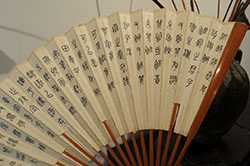| Calligraphy was brought into daily life in casual and purposeful ways. Fans provide a gentle example, existing somewhere between artworks and ephemera, often being little more than fragile toys of summer. A common performance would be to carry a fan with an appropriate poem, teasingly letting others glance at it when the fan opened. Similarly, the use of calligraphy in everyday correspondence was an important consideration for self-expression and the management of relationships with others. Attention to calligraphic composition tended to encourage brevity and a more poetic (or boldly declarative) language style as well. In modern times, calligraphy has been favoured for protest posters, offering a rich combination of graphic impact and hand-wielded sincerity. The contemporary example here comes from the rather verbose efforts of TSANG Tsou-Choi (曾灶財 1922-2007), self-proclaimed 'King of Kowloon'. For fifty years, he wrote on walls, poles, concrete pylons and public installations across Kowloon and Hong Kong. Tsang's hundreds of inscriptions recounted his family lineage to support (unlikely) land claims to parts of Kowloon. His calligraphy became a ubiquitous part of the city texture, and his dogged persistence kept it in the public eye even as authorities followed, covering over or cleaning away his claims. Tsang was reckless, daubing his messages in prominent public places. He was stopped and arrested repeatedly, but he always returned to his task. To most people he was a village madman, to others an artist of quixotic resistance. | | 
 |